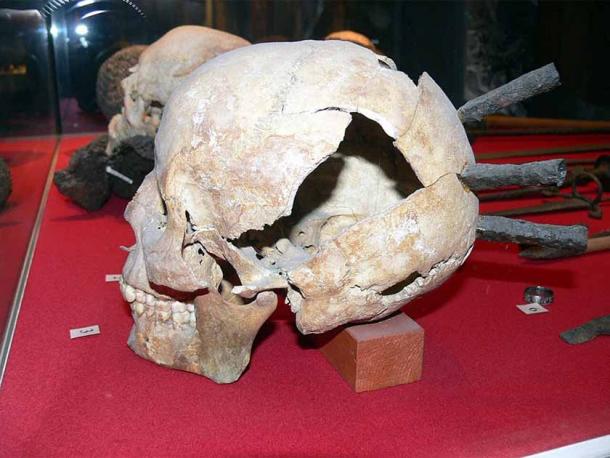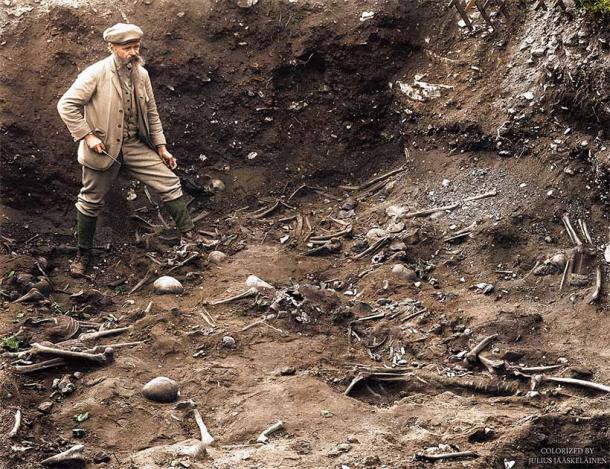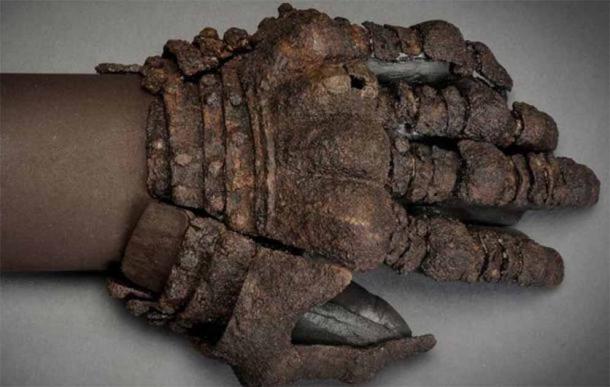The Battle of Visby was a violent medieval battle near the town of Visby on the Swedish island of Gotland, fought between the inhabitants of Gotland and the Danes, with the latter emerging victorious.

The Battle of Visby left a lasting archaeological legacy; as masses of slaughtered soldiers and citizens lay scattered across what was once a bloody battle field. Slashed and broken bones, skeletons still in their chain mail and armor, and smashed skulls, some still with spears and knives protruding out of them. One can only imagine what they endured before they breathed their last breaths.

Victim of the Battle of Visby in 1361. (Wolfgang Sauber / CC BY-SA 3.0)
Backdrop to the Battle of Visby: A Greedy King Set’s His Sights on Visby
During the Middle Ages, the island of Gotland, situated in the Baltic Sea off the coast of Sweden, occupied a significant position in the complex web of trade networks connecting Europe and Russia. This strategic location made the city of Visby, nestled on Gotland’s shores, a thriving hub for commerce and cultural exchange.
From the late 13th century onward, Visby became an integral member of the Hanseatic League, a confederation of merchant towns spanning Northwestern and Central Europe. The Hanseatic League, beyond facilitating trade, acted as a protective and defensive alliance, ensuring the security and interests of its member cities.
- The Battle of Grunwald: An Iconic Medieval Battle of Central and Eastern Europe
- Sweden’s Mysterious Shipwrecks Found Full of Medieval Household Goods
However, as the Hanseatic League’s influence expanded, it began to cast a shadow that some rulers found unsettling. Among those perturbed was Valdemar IV, the King of Denmark. Valdemar harbored dissatisfaction over the Hanseatic League’s perceived rivalry with his kingdom’s trade interests and coveted the wealth amassed by the league’s member towns.
By the middle of the 14th century, Visby, despite its continued affiliation with the Hanseatic League, experienced a decline as a significant trading center. This situation did not escape Valdemar’s attention, prompting him to focus his ambitions on capturing the city. Moreover, rumors circulated that the inhabitants of Visby sang derisive drinking songs mocking the Danish king, fueling his personal vendetta against them.
Valdemar IV’s motivations to attack Visby, therefore, stemmed from a combination of economic rivalry, territorial ambitions and personal grievances. This multifaceted backdrop set the stage for the violent confrontation that would become known as the Battle of Visby in 1361, ultimately reshaping the fate of this once-thriving medieval trading city.

Valdemar Atterdag holding Visby to ransom in 1361, by Karl Gustaf Hellqvist. (Public domain)
The Danish Invasion and the Battle of Visby
In the summer of 1361, a Danish army set sail for Gotland. The inhabitants of Visby had been warned about the invading Danish force and prepared themselves for the battle. In late July 1361, Valdermar’s army landed on the west coast of Gotland. The Danish army numbered between 2,000 and 2,500 men, and was comprised mainly of experienced Danish and German mercenaries. The defending Gotlanders, on the other hand, numbered around 2,000, and were militiamen with little or no experience of battle.
The Gotlanders first tried to halt the advance of the Danish army at Mästerby, in the central part of the island. The defenders were crushed at Mästerby and the Danes continued their march towards Visby.
The Battle of Visby was fought before the walls of the town. Although the militiamen were fighting for their lives, and fought as best as they could, they were simply no match for the professional Danish army. As a result, the majority of the defenders were killed and the town surrendered to Valdemar.

The first excavation of the mass graves from the Battle of Visby in 1361, led by Oscar Wilhelm Wennersten in 1905. (Julius Jääskeläinen / CC BY 2.0)
Excavations of the Battle of Visby’s Mass Graves
Those who fell during the battle were buried in several mass graves and were left in peace until the 20th century. Between 1905 and 1928, the mass graves were discovered and subsequently excavated. More than 1,100 human remains were unearthed, providing archaeologists with a plethora of information about the battle.
The types of weapons used during the Battle of Visby could be determined based on the injuries left on these remains. About 450 of these wounds, for instance, were inflicted by cutting weapons, such as swords and axes, whilst wounds inflicted by piercing weapons, such as spears and arrows, numbered around 120.
- Axe-Wounded Visby Warrior Brought to Life Over 600 Years Later
- Hidden Horrors: 10 of History’s Most Shocking Mass Graves
By studying the bones left behind in the wake of the Battle of Visby, it was also found that at least a third of the defenders of Visby were the elderly, children or the crippled, an indication that the situation was very dire indeed for the townsfolk.

Armored glove found at Visby. (Gabriel Hildebrand)
Fallen Soldiers from the Battle of Visby
It is assumed that the dead were buried quickly after the battle, and therefore were interred with the equipment they had during the battle, which included their armor and weapons. Thanks to their excellent state of preservation, these remains are a unique archaeological find.
Although not many of the defenders were well-equipped for the battle, there are several examples of chainmail shirts, coifs, gauntlets and a variety of weapons. These incredible remains, along with the human remains, are today displayed in the Gotland Museum and remain as a lasting legacy to the defenders of Visby.





